Auctions
Christie’s Makes Market History With $786 Million Evening Sale Led by Record-Smashing Leonardo da Vinci
It was the highest total for an evening sale since the house's November 2014 contemporary auction, the priciest ever held.
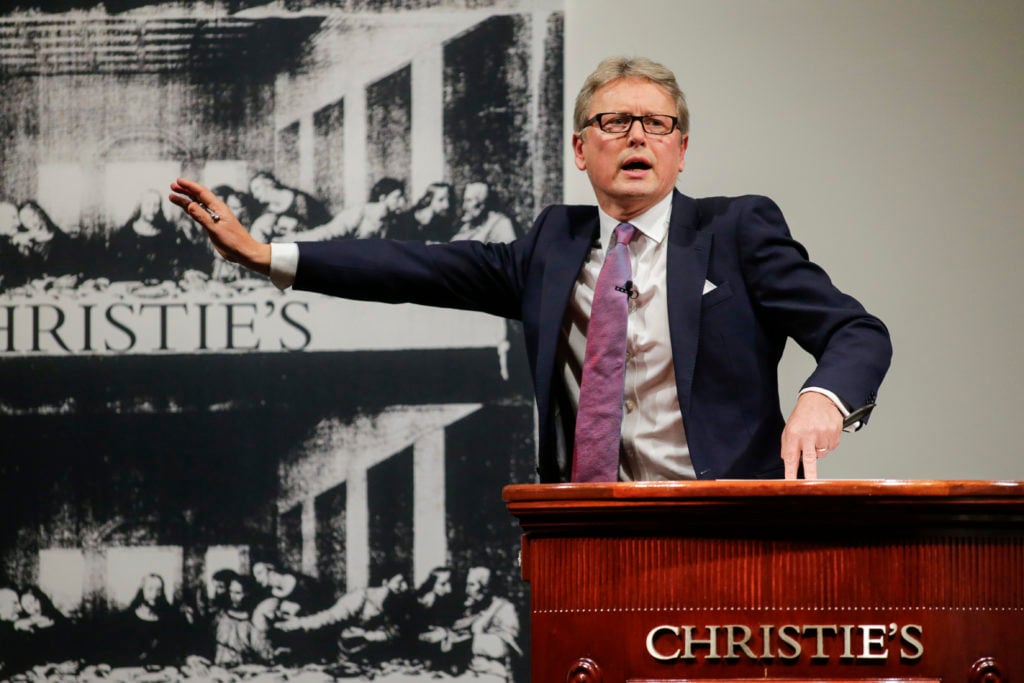
It was the highest total for an evening sale since the house's November 2014 contemporary auction, the priciest ever held.

Eileen Kinsella &
Caroline Goldstein

Christie’s much-hyped sale of postwar and contemporary art at New York’s Rockefeller Center on Wednesday evening exceeded all expectations—at least for the painting that mattered most. The sale raked in $785.9 million. It was the highest total for an evening auction since the house’s record-demolishing November 2014 contemporary sale, which at $852.9 million remains the priciest ever held.
Leonardo da Vinci’s Salvator Mundi (c. 1500) accounted for more than half of the night’s total—and set a new high-water mark for a work of art sold at auction. All told, the sale soared above the overall presale estimate of $410 million and significantly surpassed last year’s equivalent sale, which made $276.9 million.
The star of the night was, unquestionably, Leonardo. After a relentless bidding war that lasted a full 19 minutes, the last known work by the Renaissance master in private hands sold for $450.3 million, more than four times its estimate of about $100 million. (Final prices include the auction house buyer’s premium; estimates do not.)
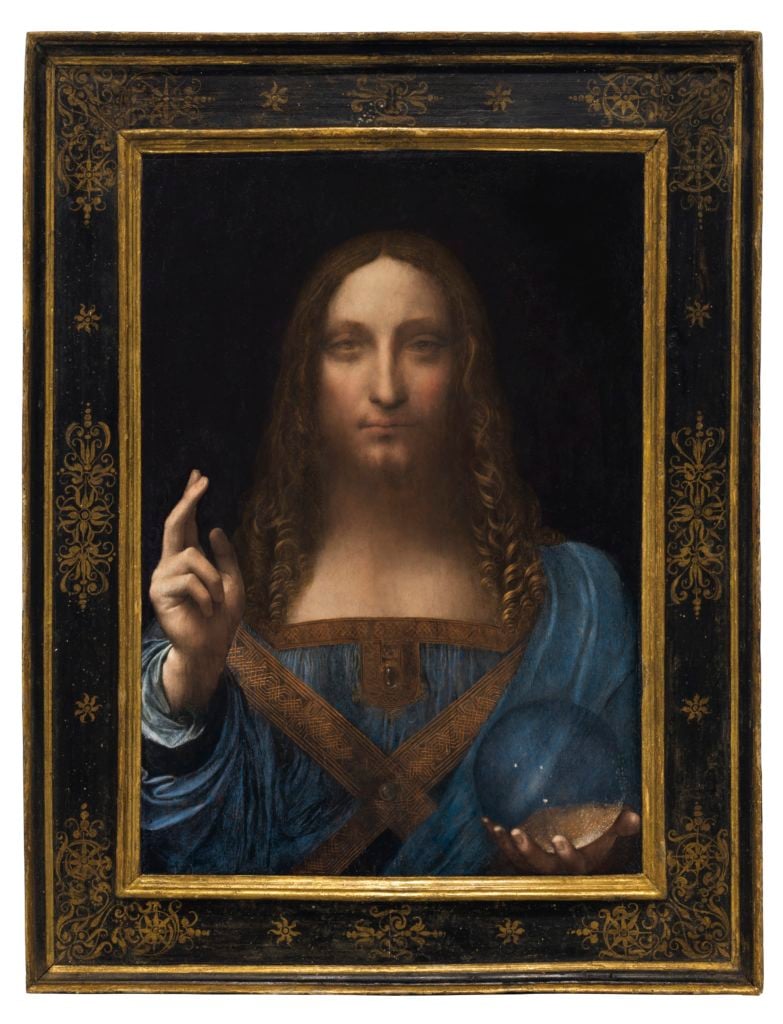
Leonardo da Vinci’s Salvator Mundi. Courtesy of Christie’s Images Ltd. 2017.
Of the 58 lots on offer, 49—or 84 percent—sold. But nothing else in the sale could possibly compare to the fireworks early on in the proceedings: the Leonardo was lot number nine. Nevertheless, auctioneer and Christie’s global president Jussi Pylkkänen proved more than adept at handling this obstacle.
After the Leonardo painting sold, there was a mini-exodus from the salesroom. But Pylkkänen kept the mood light, humorous, and efficient, moving at a fast clip. Perhaps aware that the remaining lots would pale in comparison to the evening’s star, he seemed intent on pushing buyers to make decisions quickly, even if it meant numerous works just met or hovered near their low estimates.
(By contrast, as bidding for the Leonardo stalled below $300 million before picking up steam again, Pylkkänen seemed like there was nowhere else in the world he needed to be. “It’s an historic moment—we’ll wait,” he said.)
Beyond the marquee lot, the sale saw new auction records for artists including Hans Hofmann ($8.9 million), Kerry James Marshall ($5 million), Philippe Parreno ($516,000), Lee Krasner ($5.5 million), Julian Schnabel ($1.5 million), and William Baziotes ($1.3 million).
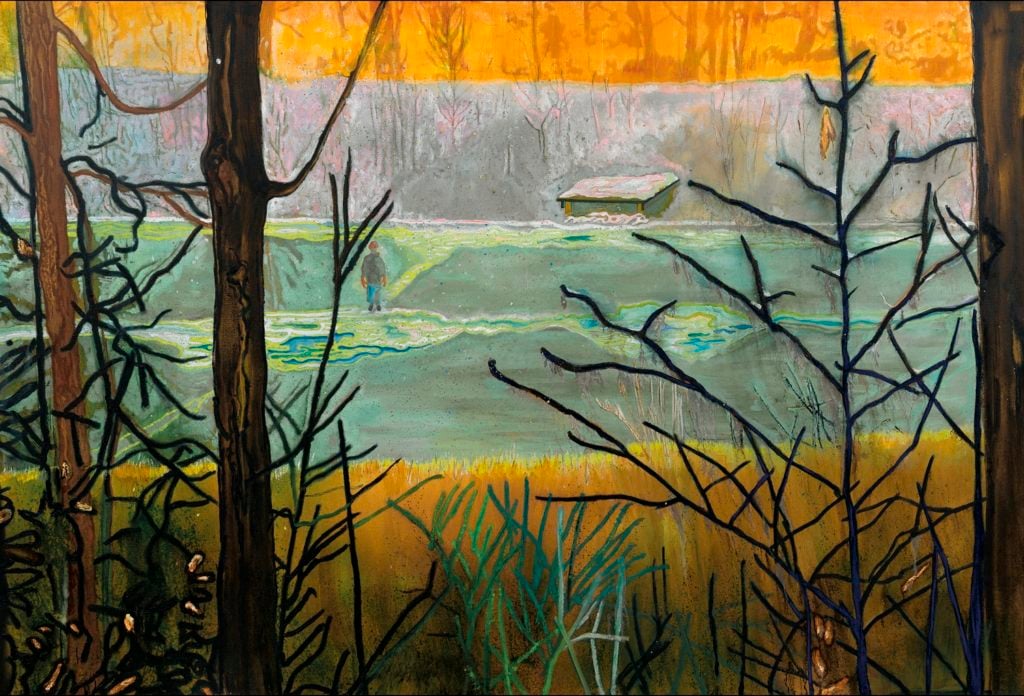
Peter Doig’s Almost Grown (2000). Courtesy of Christie’s Images Ltd.
With the room still buzzing after the da Vinci, just four lots later it was time for another high-wattage work: Andy Warhol’s massive Sixty Last Suppers (1986), estimated “in the region of $50 million.” Bidding was measured, if solid, for the 10-by-33-foot painting. It started at $42 million and relatively quickly moved up to $56 million before being hammered down to a phone bidder for $60.9 million with premium. The highest price ever paid for a Warhol is $105.4 million for Silver Car Crash (1963), which sold at Sotheby’s in 2013.
Christie’s had been heavily playing up the Warhol’s da Vinci connection, having unveiled the works together last month. According to the catalogue essay, Sixty Last Suppers—which had never appeared at auction before—represents a moment in Warhol’s career when he reclaimed “the ghosted image of the painting that ushered in the Renaissance” and sought to create a canvas more fresh and powerful than Leonardo’s original.
The sale also featured a number of fresh-to-market works from prestigious private collections. These included 15 works from the Eppler family collection, a trove of Modern works amassed by Heinz Eppler, the late CEO of a public retail chain, and his wife Ruthe. All but one of the works on offer sold for a combined total of $71 million.
The Eppler collection also produced the new record for Hofmann. His painting Lava (1960) sold for $8.9 million (estimate: $4–6 million), surpassing his previous $6.3 million high mark at auction, set at Christie’s in 2013.
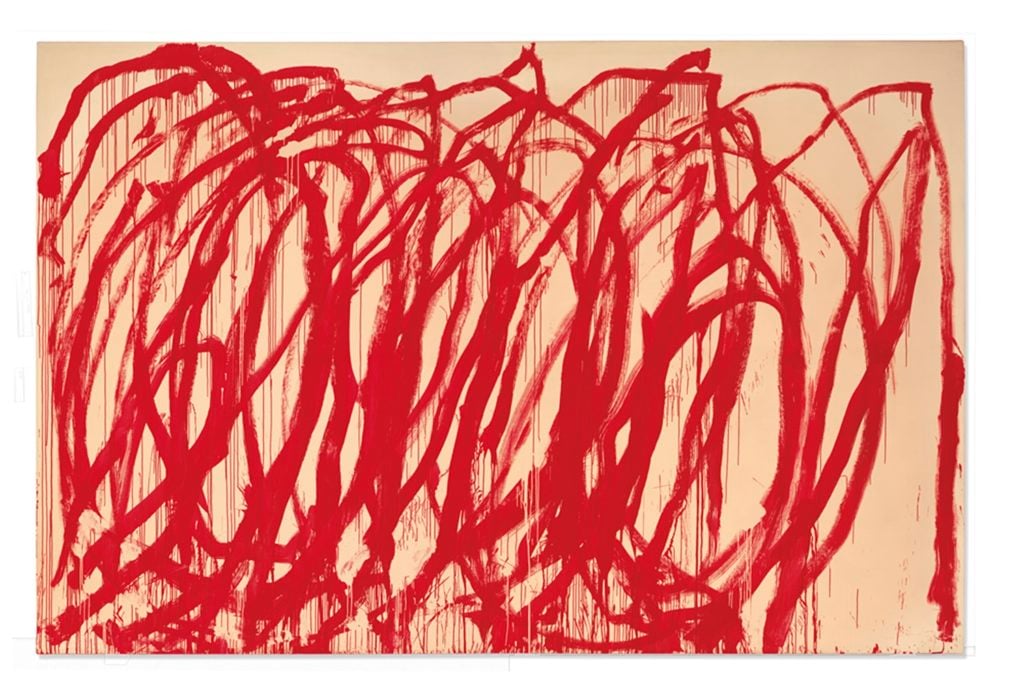
Cy Twombly’s Untitled (2005). Courtesy of Christie’s Images Ltd.
Meanwhile, one of several works from the collection of Texas philanthropists Nancy and Perry Bass, a vibrant Alexander Calder painting, ignited serious interest. Seven Black, Red and Blue (1947), estimated at $900,000–1.2 million, hammered down for $2.8 million to a gentleman seated in the room.
Cy Twombly, a reliable hit at the marquee evening sales, also had a successful night. Untitled (2005), a canvas with huge looping red scrawls, was estimated to exceed $40 million, and Pylkkänen opened bidding at $30 million. It sold for $46.4 million with premium. Christie’s called the painting, which the consignor acquired from Gagosian Gallery in New York, one of the artist’s “last great works.”
Shortly after that, another Twombly, titled Sunset (1957) and featuring the artist’s signature scribblings on a white background, sold for $27.3 million after a brief bidding contest. The unpublished estimate on the work was $20 million.
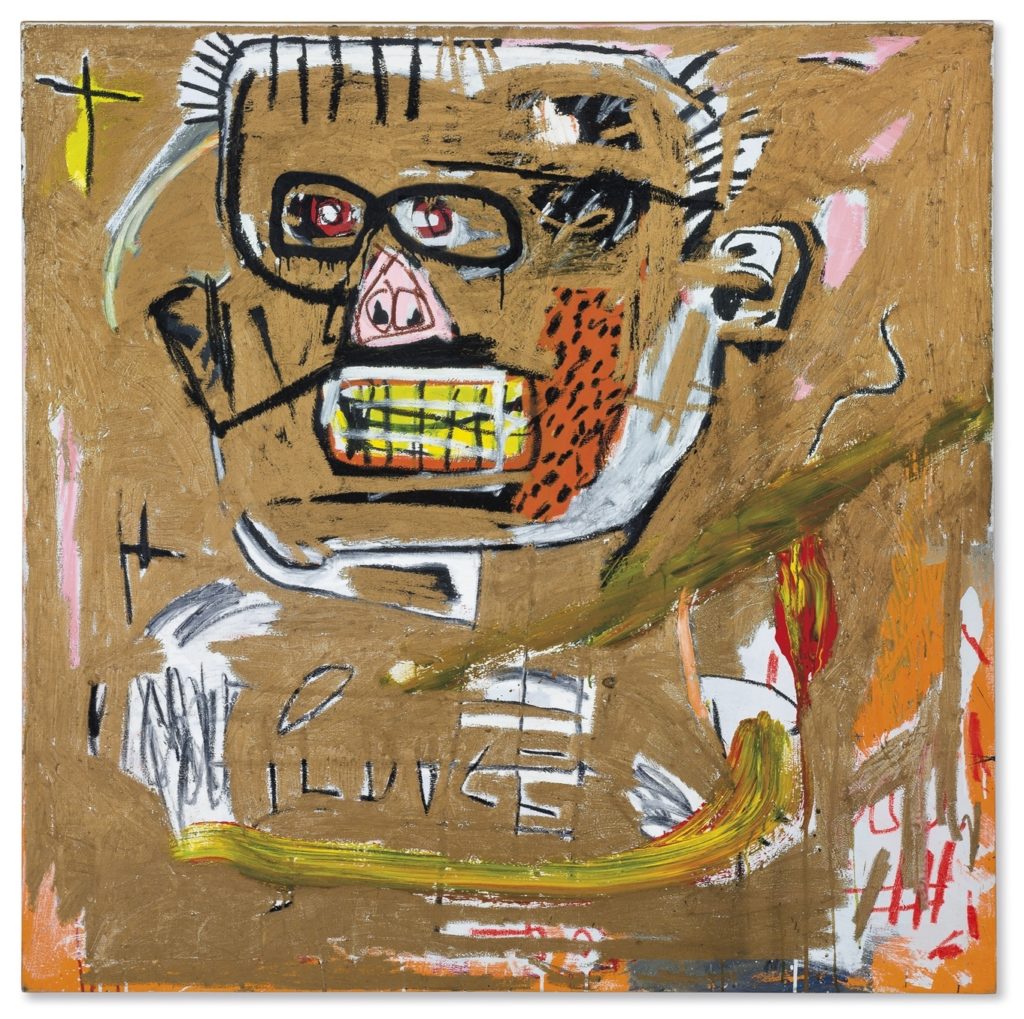
Jean-Michel Basquiat’s II Duce (1982). Courtesy of Christie’s Images Ltd.
Not every lot met expectations, however. One high-profile—and surprising—loss was the lot that immediately followed the Leonardo: Jean-Michel Basquiat’s Il Duce (1982), estimated at $25–35 million. The Basquiat market has been on a hot streak lately, and works from 1982 are particularly coveted.
Basquiat painted the work on one of his trips to Italy; dealer Bruno Bischofberger acquired it directly form the artist before selling it to a private Swiss collection, where it remained for several decades. But bidding on the painting was thin and it failed to meet its reserve, despite the fact that it had never appeared at auction before.
Demand was also somewhat lackluster for another auction star, Peter Doig, whose Almost Grown (2000) was estimated at $10 million to $15 million. Bidding opened at $7 million and got no higher than $9 million, despite Pylkkanen’s repeated attempts at coaxing.
The work eventually sold to a Christie’s specialist handling a phone bid for $10.4 million with premium (but the price fell below estimate without the added fees). Perhaps buyers were not interested in such a dramatic markup: The same work sold at Sotheby’s London in 2009 for £2 million ($3.4 million).
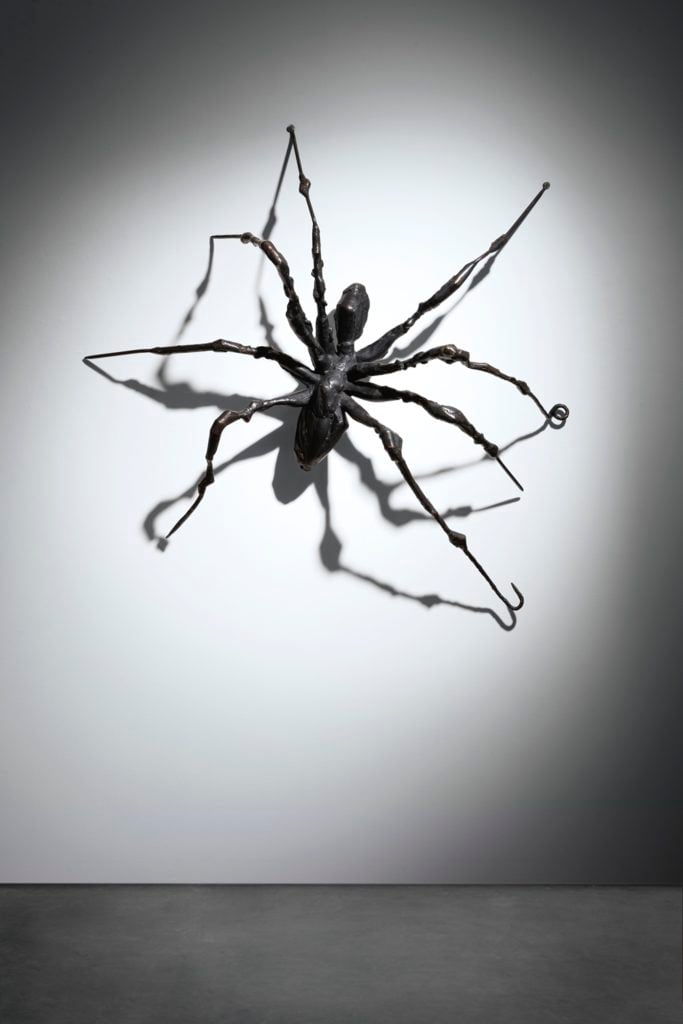
Louise Bourgeois’s Spider II (1995). Courtesy of Christie’s Images Ltd.
Christie’s head of sale and international specialist for postwar and contemporary art, Loïc Gouzer, was active throughout the evening. He submitted the winning bid on behalf of a client for Louise Bourgeois’s Spider II (1995) estimated at $10–15 million. It hammered down at $9.8 million, or $11.6 million with premium.
But Gouzer, like most Christie’s staff, was all about Leonardo this evening. He had helped conceive the (wildly successful) stunt to sell the Renaissance work in the contemporary sale. After Alex Rotter, Christie’s global co-head of contemporary art, submitted the winning $400 million bid for the painting, he hung up the phone and planted a kiss squarely on Gouzer’s head—a gesture worthy of the Vatican.